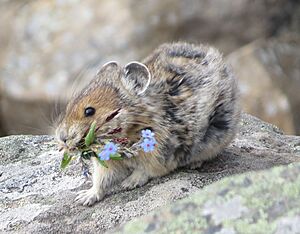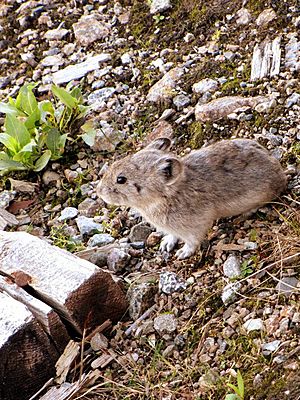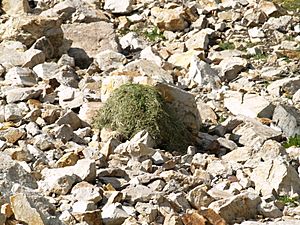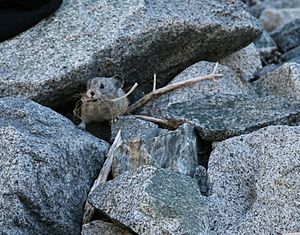Pika facts for kids
Quick facts for kids Pika |
|
|---|---|
 |
|
| American pika (Ochotona princeps) | |
| Scientific classification |
|
| Kingdom: | Animalia |
| Phylum: | Chordata |
| Class: | Mammalia |
| Order: | Lagomorpha |
| Family: | Ochotonidae Thomas, 1897 |
| Genus: | Ochotona Link, 1795 |
| Type species | |
| Ochotona daurica Link, 1795
(Lepus dauuricus Pallas, 1776) |
|
| Species | |
|
See text |
|
A pika ( PEYE-kə) is a small, mountain-dwelling mammal native to Asia and North America. With short limbs, a very round body, an even coat of fur, and no external tail, they resemble their close relative, the rabbit, but with short, rounded ears. The large-eared pika of the Himalayas and nearby mountains lives at elevations of more than 6,000 m (20,000 ft).
The name "pika" appears to be derived from the Tungus pika, and the scientific name Ochotona is derived from the Mongolian word ogotno, оготно, which means pika. It is used for any member of the Ochotonidae, a family within the order of lagomorphs, the order which also includes the Leporidae (rabbits and hares). They are the smallest animal in the lagomorph group. Only one genus, Ochotona, is extant within the family, covering 37 species, though many fossil genera are known. Another species, the Sardinian pika, belonging to the separate genus Prolagus, has become extinct within the last 2000 years owing to human activity.
Pikas prefer rocky slopes and graze on a range of plants, primarily grasses, flowers, and young stems. In the autumn they pull hay, soft twigs, and other stores of food under rocks to eat during the long, cold winter. The pika is also known as the whistling hare because of its high-pitched alarm call it gives when alarmed. The two species found in North America are the American pika, found primarily in the mountains of the western United States and far southwestern Canada, and the collared pika of northern British Columbia, the Yukon, western Northwest Territories and Alaska.
Habitat

Pikas are native to cold climates in Asia and North America. Most species live on rocky mountainsides, where numerous crevices are available for their shelter, although some pikas also construct crude burrows. A few burrowing species are native to open steppe land. In the mountains of Eurasia, pikas often share their burrows with snowfinches, which build their nests there. Changing temperatures have forced some pika populations to restrict their ranges to even higher elevations.
Characteristics
Pikas are small mammals, with short limbs and rounded ears. They are about 15 to 23 cm (5.9 to 9.1 in) in body length and weigh between 120 and 350 g (4.2 and 12.3 oz), depending on species.
These animals are herbivores and feed on a wide variety of plant matter, including forbs, grasses, sedges, shrub twigs, moss and lichens. Easily digestible food is processed in the gastrointestinal tract and expelled as regular feces. But in order to get nutrients out of hard to digest fiber, pika ferment fiber in the cecum (in the GI tract) and then expel the contents as cecotropes, which are reingested (cecotrophy). The cecotropes are then absorbed in the small intestine to utilize the nutrients.
Collared pikas have been known to store dead birds in their burrows for food during winter and eat the feces of other animals.
As with other lagomorphs, pikas have gnawing incisors and no canines, although they have fewer molars than rabbits. They have a dental formula of: 2.0.3.21.0.2.3 = 26. Another similarity that pikas share with other lagomorphs is that the bottom of their paws are covered with fur and lack paw pads.
Rock-dwelling pikas have small litters of fewer than five young, whilst the burrowing species tend to give birth to more young and to breed more frequently, possibly owing to a greater availability of resources in their native habitats. The young are born altricial (eyes and ears closed, no fur) after a gestation period of between 25 and 30 days.
Activity
Pikas are active during daylight (diurnal) or twilight hours (crepuscular), with higher-elevation species generally being more active during the daytime. They show their peak activity just before the winter season. Pikas do not hibernate and remain active throughout the winter by traveling in tunnels under rocks and snow and eating dried plants that they have stored. Rock-dwelling pikas exhibit two methods of foraging: the first involves direct consumption of food, and the second is characterized by the gathering of plants to store in a "haypile" of cached plants.
The impact of human activity on the tundra ecosystems where pikas live has been recorded dating back to the 1970s. Rather than hibernate during winter, pikas forage for grasses and other forms of plant matter and stash these findings in protected dens in a process called "haying". They eat the dried plants during the winter. When pikas mistake humans as predators, they may respond to humans as they do to other species that do prey on pikas. Such interactions with humans have been linked to pikas having reduced amounts of foraging time, consequentially limiting the amount of food they can stockpile for winter months. Pikas prefer foraging in temperatures below 25 °C (77 °F), so they generally spend their time in shaded regions and out of direct sunlight when temperatures are high. A link has also been found between temperature increases and lost foraging time, where for every increase of 1 °C (1.8 °F) to the ambient temperature in alpine landscapes home to pikas, those pikas lose 3% of their foraging time.
Eurasian pikas commonly live in family groups and share duties of gathering food and keeping watch. Some species are territorial. North American pikas (O. princeps and O. collaris) are asocial, leading solitary lives outside the breeding season.
Vocalization
Pikas have distinct calls, which vary in duration. The call can be short and quick, a little longer and more drawn out or long songs. The short calls are an example of geographic variation. The pikas determine the appropriate time to make short calls by listening for cues for sound localization. The calls are used for individual recognition, predator warning signals, territory defense, or as a way to attract potential mates. There are also different calls depending on the season. In the spring the songs become more frequent during the breeding season. In late summer the vocalizations become short calls. Through various studies, the acoustic characteristics of the vocalizations can be a useful taxonomic tool.
Lifespan
The average lifespan of pikas in the wild is roughly seven years. A pika's age may be determined by the number of adhesion lines on the periosteal bone on the lower jaw. The lifespan does not differ between the sexes.
Images for kids
-
Fossil occurrences of leporids and ochotonids and global environmental change (climate change, C3/C4 plants distribution)
See also
 In Spanish: Ochotona para niños
In Spanish: Ochotona para niños





